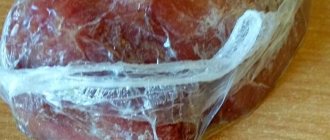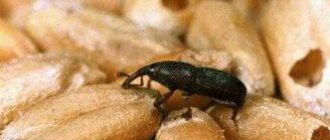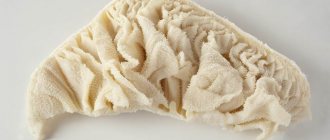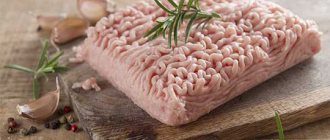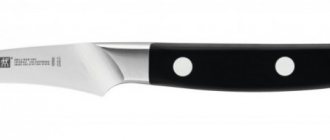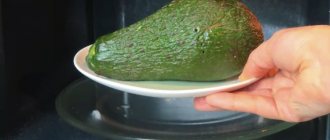On the one hand, freezing food eliminates the need to frequently visit the store. On the other hand, quickly defrosting the same meat and fish without a microwave is quite problematic. They can thaw for up to 30 hours if everything is done according to the rules and the temperature is increased gradually. But what to do if you are running out of time to prepare a dish? After all, it is not always possible to predict cooking in advance.
How to freeze cottage cheese correctly
So, we found out that even cottage cheese can be frozen. But how to perform this procedure in order to leave the product with maximum consumer properties? Let's consider the main requirements that should be followed to achieve the desired goal.
Divide the cottage cheese into portions
Suppose we bought 1 kg of product in a bag and froze it entirely in the same container, and after a couple of days we decided to have 200 grams for breakfast. And in order to get this amount, we must defrost the entire package. And now we have the required glass of cottage cheese, but what to do with the rest - freeze it again? It won’t work, otherwise it will spoil when defrosted again. All that remains is to consume 1 kg entirely.
To avoid such a mishap, before freezing, consider how much on average you need to use. Typically, the amount for consumption and for use in dish recipes is 200 g, so the best option would be to distribute exactly these proportions into containers for freezing. You can always defrost a larger quantity if necessary by removing two or more bags.
Mark
In order not to forget where the cottage cheese is “late” and “early” frozen, for proper rotation and compliance with the principle of warehouse logistics (no matter how strange it may sound) - FIFO (First In, First Out, which means “first in, first out”) , mark the container with the product with the packaging date. Agree, sometimes it’s difficult to remember how long ago and when we froze the meat we packed ourselves. And with cottage cheese it will be the same, but with one exception - even in frozen form, in comparison with the other “inhabitants” of the freezer, it can be classified as perishable.
This advice will allow you to avoid an unpleasant sour surprise in the form of cottage cheese that “seems to have been packaged a week ago” and will help you keep track of how soon you need to consume the fermented milk product and which of the bags should be taken first.
Use special containers for freezing
Please note what we store the frozen food in - as a rule, it is a plastic bag in which the product was packaged for us upon purchase by caring sellers. Harsh frozen storage conditions eventually lead to “burns” of the cottage cheese in places of contact with the walls of the freezer - thin cellophane does not provide the necessary preservation, and as a result we get an overdried consistency
An airtight container and a special freezing bag will provide reliable protection so that after defrosting the consistency of the cottage cheese remains as close to its original consistency as possible. The principle of operation is to remove air from the container, in other words, it will be airtight. The absence of any gases in the container and bag prevents the formation of ice crystals on the product, which are the cause of the previously mentioned “cold burns”.
Grind cottage cheese
And this is not a typo. It is really worth crushing the cottage cheese, since it tends to clump into large lumps, which freeze more slowly. And it is they who will be subject to rapid deterioration over time. Don’t be lazy and crumble the curd lumps into individual grains.
Check product freshness
For freezing, you need to use almost freshly made cottage cheese. By freezing the product on the last day of the shelf life, you also freeze all the putrefactive microflora that has begun to develop, and the number of beneficial bifidobacteria by this moment is already reduced to 0.
As a result, we will highlight the main materials for proper freezing - bags with a slide lock, small sealed plastic containers, scales and a marker.
"Restoration work"
A loaded freezer works more efficiently than a half-empty one due to the lack of air circulation.
High-quality freezing lasts at least 5–6 hours. Even a properly packaged product loses quality over time. It is not recommended to store cottage cheese in the freezer for more than 2 months.
The optimal shelf life of the frozen product is one month. Exceeding this period leads to the loss of its consumer qualities: defrosted cottage cheese takes on a powdery form and completely loses its taste, although it does not cause any noticeable harm to the body. Prolonged freezing will simply lead to inevitable loss of moisture.
The likelihood of drying out will be much reduced if all air is carefully removed from plastic bags with cottage cheese. The higher the fat content of the cottage cheese and the lower the whey content in it, the less freezing will affect the quality. You can refine “overdried” cottage cheese by mixing it with fresh heavy cream or soaking it in milk for 2 hours.
There is no consensus among nutritionists regarding the speed of defrosting cottage cheese. Most of them are inclined to defrost it slowly. This can be done quickly by immersing its sealed packaging in a bag in hot water.
How to properly store cottage cheese at home
How long can bread be stored: in the room, refrigerator, freezer
The most optimal solution for storing cottage cheese is the refrigerator. It should be taken into account that after 24 hours of storage, the product is not recommended to be consumed directly; it is better to subject it to heat treatment.
There are also situations when there is no refrigerator in the house (for example, it has fallen into disrepair). How long does cottage cheese last at room temperature? The maximum permissible period is up to 5 hours, if the product was lying next to heating devices - no more than 2 hours.
There are several unique ways that have been used since ancient times to increase this period:
- Wrap the curd in a clean white cloth, previously soaked in cold water. Place the “bundle” in a cooler place, with a temperature no higher than 15 degrees.
- Use foil or parchment paper. Then place in an enamel bowl and close the lid tightly. If you put a few pieces of sugar in the container, the shelf life will increase.
Beneficial and harmful properties of frozen cottage cheese
How long can soup be stored in the refrigerator and freezer: shelf life of first courses
The product is the result of separating the milk base from the whey, which causes high concentrations of nutrients in it. The lactic acid bacteria present in it break down proteins into amino acids, speeding up important body processes. In a product frozen according to the rules, useful components remain unchanged, which are represented by:
- Methionine is a component that prevents and slows down (if the condition has developed) atherosclerotic processes in the body.
- Choline is a compound that ensures the proper functioning of the nervous system.
- Lysine is a substance that helps the liver cope with its function.
These components make cottage cheese one of the essential baby food products. But for an adult it is also necessary, especially when there is deterioration in the functioning of the heart, digestion, and joints. In fact, it is beneficial for everyone except those people who are lactose intolerant. But the benefit is completely absent in cases where storage conditions were violated. Bacteria begin to actively develop in cottage cheese, which can cause serious food poisoning.
Reference! The low fat content of the product and the beneficial components it contains, as well as a large amount of calcium, allow it to be consumed during periods of dieting. It also contains other substances that prevent a decrease in skin tone and prevent brittleness of nails and hair with a calorie-restricted diet.
Freezing Recommendations
Is it possible to freeze cottage cheese in the freezer?
The source of calcium and protein spoils quickly, within 3-5 days. With longer storage, pathogenic microflora intensively develops in the product, so it changes the taste, and when consumed, it can cause poisoning. In order not to harm your health, but also not to throw dairy products into the trash, you just need to freeze them correctly. The following tips will help with this:
- Any cottage cheese is suitable for freezing: store-bought or homemade, there is not much difference. The grain product must be as fresh as possible and not have a sour aroma or taste;
- You will need dishes made of glass, ceramics or food-grade plastic. An airtight lid is required; it will protect against oxygen and prevent moisture loss. Moreover, cottage cheese absorbs foreign odors well, so it must be isolated from other products even when frozen;
- When filling the dishes with product, you must leave a little (about 2 cm) free space on top. When frozen, products increase slightly in volume;
- the maximum useful qualities will be preserved in the curd if you use blast freezing at a temperature of -30 degrees. Complete freezing takes 4 to 6 hours.
- the frozen product is subsequently stored in the freezer at a temperature of -18-20 degrees.
The shelf life of frozen cottage cheese is up to 6 months; if other ingredients are added to it (raisins, dried apricots, chicken eggs), then the shelf life is reduced to 4 months. A product that has already been thawed cannot be re-frozen, so you need to take care in advance and package the products in small containers so that there is enough for exactly one time.
On a note!
You can freeze not only the cottage cheese itself, but also semi-finished products based on it: cheesecakes, pancakes with cottage cheese filling, dumplings, casseroles.
How to freeze red currants for the winter - 3 freezing methods
How do I freeze compote mixture for the winter?
How to freeze strawberries at home - I show you all the ways to freeze berries
5 best ways to freeze eggplants at home in the freezer
Freezing process
It will take a little time to freeze cottage cheese; it is a simple process. The process consists of performing several sequential steps:
- if the product is too wet, transfer it to cheesecloth and wait until all the whey has drained off. This usually lasts several hours. Cottage cheese should be as “dry” as possible before freezing;
- Place the curd tightly in portions in a container or bag, leaving a little space on top. Close the jar with a lid;
- Place the sealed container with the contents in the freezer, cooled to a temperature of -30 degrees. After 4-5 hours, you can increase the temperature to -20 degrees.
You can use various containers for freezing. Suitable:
- plastic bags (preferably with clips). Fill the contents of the bag with an even thin layer of the product, and then remove the air. The less air left inside, the better the taste will be preserved. You can use a thin straw to remove it. It is inserted into the tip of an almost closed bag, and then the remaining oxygen is sucked in with the mouth, so there will be a vacuum in the bag. You can use a vacuum sealer if you have one;
Freezing cottage cheese in a bag is very convenient because after defrosting you don’t have to wait long, because the layer will melt very quickly.
- glass or plastic containers. If you don’t have a suitable lid for the jar at home, you can wrap the container in cling film. Compact containers will not take up much space in the freezer;
- disposable foil baking pans. They are ideal for packaging semi-finished products, for example, cottage cheese casserole. When the mass has melted, you can put it in the oven without transferring it to another dish.
Frozen fermented milk products completely retain their taste, structure and aroma for six months, just like their semi-finished products.
Packaging options for freezing cottage cheese
To create suitable conditions for preserving the quality of the product, you need to focus on the packaging in which it will be sent to the freezer for storage. In addition to plastic bags, which are not suitable for fermented milk products, there are other options
It is permissible to freeze cottage cheese at home in the freezer in the following types of packaging:
- vacuum;
- parchment paper and foil;
- cotton fabric;
- glass and enamel dishes;
- plastic food containers.
It is possible to organize vacuum packaging at home when you have a special device - a vacuum dehumidifier. This device is expensive, but it allows you to provide better conditions for storing different types of products, not just cottage cheese. Vacuum packaging preserves the original taste characteristics of the fermented milk product for 1 month. The integrity of the vacuum packaging should only be broken before use.
Reference! Home packaging of products using a vacuum sealer is virtually no different from industrial packaging.
To preserve its taste and consistency, cottage cheese can be wrapped in foil or parchment paper. This packaging option briefly extends its shelf life, but foil and parchment paper have another advantage. Compared to glass or enamel dishes, they help save space in the freezer.
Cotton fabric is a good option for storing fermented milk products. The cottage cheese is wrapped in a slightly damp cloth and placed in a container. The dishes are closed and sent to the freezer. This packaging method prevents weathering and preserves the necessary moisture of the product. Cotton fabric also needs to be placed between the walls of the glass or ceramic container and the cottage cheese, which preserves the friability of the product. In addition, to store it in such a container, you need to put 2-3 cubes of refined sugar in the container, which will not allow the cottage cheese to become unusable ahead of time.
Plastic containers are not suitable for storing and freezing fermented milk products. Plastic, even food grade, can absorb odors and release them to the products stored in it. Therefore, the container used must be absolutely clean and free of foreign odors. You should also place a paper towel or cotton napkin at the bottom of the plastic container. This measure will minimize contact with plastic and maintain the consistency of the curd.
Defrosting methods
Depending on the amount of free time, there are several answers to the question of how to quickly defrost dough.
Slow defrost
If there is a lot of time for preparing products, then you can use gentle defrosting methods.
- You need to remove the product from the package.
- Place it on a board or plate and leave for several hours. Typically, five hours is enough to defrost at room temperature.
- Can be defrosted in the refrigerator, on the lowest shelf. It will defrost in ten hours.
Fast defrost
When you are sorely short of time and you need to start preparing baked goods urgently, you can resort to quick defrosting methods. There is no need to worry in vain that the finished products will turn out tough or tasteless; the main thing is to follow all the rules of thawing.
- The dough is placed in a plastic bag, tied tightly and dipped in warm water. After three hours you can start baking.
- You can also defrost in the microwave using the “auto defrost” mode. If the microwave oven does not have such a function, it will be enough to turn it on at 100 watts. The main thing here is to make sure that the product does not become hot. It needs to be turned over very often.
- A regular warm battery is suitable for thawing the product. The finished frozen product must be placed on its surface directly in the package. It will defrost in an hour.
You should not use defrosting in the microwave or in warm water often, as these are not the best options for thawing the product. These methods can be safely used in the case of pizza dough, but it is better to defrost yeast or puff pastry using other methods. Do not place rolled puff pastry in the microwave, as it may spoil there.
Defrosting yeast dough
Most often, difficulties arise when working with yeast dough, which is very capricious and, if you make a mistake during defrosting, may not rise.
To understand how to defrost yeast dough, you must follow certain rules.
- You can put it in two plastic bags, release excess air and put it in warm water, which needs to be changed periodically.
- Defrost the product by placing it on the lid of a hot pan, wrapped in a bag or foil. In order for thawing to proceed evenly, it must be constantly turned over.
- To defrost, place the product in a saucepan and place it on the stove next to the lit burners.
- To quickly defrost, the product is placed in a pan and placed in a water bath. In this case, you need to make sure that it does not stick to the bottom.
It is better not to defrost yeast dough in the microwave. It is believed that yeast loses its properties with this method of thawing. But if such a need arises, then put the dough in the oven for no more than a minute, otherwise the top layer of the product will dry out.
Defrosting puff pastry
Experienced housewives can tell you how to quickly defrost puff pastry. It is not as capricious as yeast, and there are fewer problems with it. The main thing is to adhere to the basic rule: never defrost it in the microwave. The puff pastry will thaw on the counter at room temperature for two hours. For urgent defrosting, you can put it on the battery.
Puff pastry will be tastier and more tender if, after kneading, you place it in the refrigerator for an hour.
To prevent the product from becoming crusty when thawing in air, it is covered with a cloth or paper.
Each housewife has her own way of defrosting. The main thing is that it is correct and does not spoil the quality of the product. It’s better to take care of defrosting the dough early, and then tasty and airy baked goods will be guaranteed.
Experienced housewives call ways to quickly defrost dough “emergency measures” and use them only when absolutely necessary. The slightest mistake - and the dough can easily turn into a lump, covered on the outside with a dry crust.
What is useful to consider
I want to share my experience and tell you what happened. This is not the first time I’ve tried this simple recipe, and all in order to sweep away false paths and check some options. Now I know for sure that:
To ensure that the yield of cheese mass is not small, it is desirable that the fat content of kefir is not less than 3.2%
This is important, since the quality of the final product, and in general, whether the cottage cheese will turn out, depends on this. The lower the fat content of the original product, the less curd you will get, if at all. You can use kefir both in bags and in tetrapacks, it makes no difference
It freezes well in any package, as well as without it. You can even pour the kefir into an iron bowl. The curd will be very tender, with a soft, creamy structure. This is important to consider if you plan to prepare any dishes from it. This type of cottage cheese makes excellent cottage cheese cookies, very tasty!
No additional steps are needed for this recipe. Cottage cheese from frozen kefir does not need to be kept under pressure or squeezed through cheesecloth. Since it takes no more than 12-18 hours to prepare the curd, the product is fresh and therefore suitable for both adults and children. The taste of the cheese is slightly salty, suitable for both desserts and first courses and appetizers.
Freezing cottage cheese in the freezer
Simply loading the cottage cheese into a plastic bag and putting it in the freezer is not enough. At home, you need to follow rules that will prevent its damage. When it is frozen correctly, the product can be used at any time - its qualities will be preserved and dishes prepared with it will be tasty. The main principles of home freezing are:
- For freezing in a household freezer, it is recommended to use a fresh farm product; store-bought products do not tolerate this procedure well.
- There is no point in freezing a pasty curd mass; the product must be grainy, otherwise it will separate.
- It is recommended to keep it in a ceramic container that is hermetically sealed - this will prevent the product from losing moisture and preserve its taste.
- It is not recommended to fill the container to the brim, since the volume increases during the freezing process; there should be about 2 cm left to the edge.
- Plastic bags are not suitable; the product will spoil in them.
- The temperature in the freezer after freezing (in the “super freezing” mode, complete cooling time is 4-6 hours) should be at -18˚ C.
After thawing, the cottage cheese cannot be re-frozen, so the product is packaged before sending it to the freezer in small portions that can be consumed at a time. To avoid accidentally consuming a spoiled product, each container containing it must be labeled with the date of freezing. There is no difference in the preparation process and freezing of goat or cow curd.
How to preserve strawberries so that they remain fresh for a long time (there is a secret)
Strawberries are the favorite berry of adults and children, thanks to their aroma and taste. But the nutmeg strawberry season...
Taste and texture of defrosted cheese
What will we get as a result? Kefir cottage cheese in the freezer is more like cheese, which is made especially for children. This curd is not grainy, it resembles a soft, moist mass, light and tender. You can eat it once, as soon as all the ice in it has defrosted and drained. Sometimes such curd is crushed with sugar or berries or raisins are added to it if you want to eat the curd as sweet. But you can also add herbs, tomatoes or olives with nuts.
The creamy curd mass is already a ready-made filling for many dishes. Just take into account its soft texture. Perhaps, if it is one of the ingredients of the dough, you will have to add a little more flour or semolina. Fillings, sauces or creams, on the other hand, require fewer liquid and creamy ingredients so that their texture allows them to be absorbed but not leaked out of the dish.
How to defrost meat in the oven?
Defrosting meat products in the oven has a number of advantages over other methods:
- defrosting occurs more evenly
- the process is significantly accelerated
- the meat inside the chamber does not become chapped or dry out
- the fibers retain their structure and meat juice does not leak out
Many modern models of ovens even have a defrosting function, which greatly facilitates the housewife’s work. In the event that your household appliances do not have such characteristics, meat can be defrosted in two ways.
Thaw meat in the oven
With temperature (accelerated method):
- Set the cabinet temperature to 30 degrees
- remove the packaging from the meat
- place in the oven for 8-10 minutes
- Check the defrost level periodically
Be careful not to overdo it with the temperature, otherwise your product will not thaw, but will bake: the inside will remain raw, and a crust will form on top.
Using convection (longer process):
- turn on the convection mode, if present on your device
- do not use the heating option
- place the product in the center of the rack
The fan creates air movement, which allows for more even defrosting. The product ultimately retains its beneficial qualities and is practically no different from fresh analogues.
Basic recommendations for thawing food in the oven:
- place the plate with meat on the grill
- It is better to use ceramic dishes
- you can cover the piece with some kind of bowl or plate - this will slow down the process a little, but the meat will turn out more tender and will not dry out
- Turn the product periodically for more even thawing.
Shelf life
In a regular refrigerator, homemade cottage cheese is usually stored for no more than four days, while store-bought cottage cheese, to which some preservatives are often added, can “live” for up to a week. Moreover, a product frozen according to all the rules described above can, in some cases, be stored for up to two months, which significantly increases its chances of being used. As part of semi-finished products, the curd filling can, in some cases, be stored even longer.
It should be understood that all specified deadlines will be met only if the cottage cheese is frozen correctly, otherwise it can be considered spoiled already on the day of freezing.
How to keep it fresh for a long time
Low-fat cottage cheese has the longest shelf life. According to the rules, it is made from milk after separation - removal of cream. Dairy products are stored a little worse (5-9%). Cottage cheese 12-18% sours faster and becomes slimy.
How to keep cottage cheese fresh for a long time in the refrigerator:
- Immediately after purchasing, divide the weight of cottage cheese into portions and transfer from the bag to an airtight container.
- You can place a piece of sugar at the bottom. It will extend shelf life and improve taste.
- Place on the refrigerator shelf.
To prevent the cottage cheese from drying out on top, we recommend choosing containers according to size. Can be covered with cling film.
Storing cottage cheese at home
Storage conditions
The optimal storage location is the refrigerator. The recommended temperature according to SanPin requirements is from 2 to 6°C, freezing is allowed at parameters -1-0. In this way, you can increase the shelf life by 1-2 days.
What should you store it in?
For store-bought cottage cheese, the best option is factory packaging. There is no need to open it in advance, introduce oxygen and microbes. The situation is more complicated with loose and homemade fermented milk products.
Housewives often use plastic containers for storage. We strongly do not recommend doing this. Such dishes spoil the taste and accelerate rotting. An alternative is ceramic, glass, enamel containers with lids.
What you can do:
- ceramic, enamel containers;
- glass containers;
- vacuum bags;
- foil, parchment;
- cotton fabric.
What should not be stored in:
- plastic bags;
- plastic containers;
- open plates, bowls;
- metal containers.
Vacuum
Vacuum bags are ordinary, the air is squeezed out, the edges are sealed. There are also special bags and devices for removing oxygen. In the first case, the shelf life is 4-7 days. If you have a special device, the storage period increases to a month. You can freeze in vacuum bags, which is not recommended in regular polyethylene.
Foil and parchment paper
Modern thin parchment is not suitable for storage. You need thick sheets, there may be problems finding them. Foil is more affordable, it has many advantages, it is ideal for storage, and extends shelf life. It is easy to tear off a sheet of the desired size, form a container of the desired size, and seal without additional tools.
Cotton fabric
Weighing to remove whey is carried out in linen bags. Preferably lint-free cotton fabric is used. You can also store finished dairy products in it. We recommend using a bowl to protect the shelves from whey. The lid will help prevent the absorption of foreign odors. It can easily be replaced with parchment or food foil.
Signs of spoiled cottage cheese
When buying food products, each of us looks at the expiration dates: is it not out, is it running out? But it may happen that careless manufacturers or sellers do not create the necessary conditions for the product. Then it might go bad. What are the signs of spoiled curd food?
- Fresh product is a uniform white color, with a slight yellow tint allowed. Strong yellowness indicates deterioration of the goods.
- The mass should be homogeneous, without lumps that vary greatly in size. If this is not the case, it means the expiration date has expired.
- Fresh products have a faint sour odor and a slight taste of milk; spoiled products have a pronounced sour odor, unpleasant taste, with notes of mold.
Many people buy cottage cheese exclusively in the store, but there are also those who prefer only the product purchased at the market. In both cases, there is a risk of buying a low-quality product.
Let's figure out what you need to pay attention to in order to choose natural and high-quality cottage cheese from the whole variety of products.
- Package. It must be airtight, so the risk of pathogenic bacteria getting into the cottage cheese will be minimal.
- Best before date. Real cottage cheese, according to GOST, can be stored for no more than 72 hours. If this number is higher, then you have a product with additives.
- Name on the label. According to the law, a product containing starch and vegetable fats cannot be called cottage cheese (such products are called differently - cottage cheese, curd mass or curd product).
- Ingredients on the label. The name “cottage cheese” must be indicated, as well as the number of lactic acid bacteria.
- Color. Natural cottage cheese must be white or white-cream.
- Price. It cannot be very low, since a lot of milk is used to make cottage cheese.
- The smell is neither sweet nor sour.
- Taste – without acid and bitterness.
- The structure of the cottage cheese must be crumbly; it is this property that will help distinguish real cottage cheese from the curd mass.
At home, it is possible to check cottage cheese for the presence of the following additives:
- Starch. If you drop a drop of an alcohol solution of iodine on the cottage cheese and it turns blue, it means that the product you purchased contains starch.
- Vegetable fats. To check, place a small amount of cottage cheese on a plate and leave in a warm place for one day. If the product dries and becomes crusty, no sour smell appears and no yellow spots form on its surface, then the cottage cheese is natural. If everything is the other way around, it means this is a fake.
When purchasing a homemade product, a person has no way to check the date of manufacture. Milk that has not been sterilized is most vulnerable to spoilage.
After a couple of days of storage, the cottage cheese begins to lose its freshness and usefulness. The best way to dispose of a large amount of stale product is to use it to make dumplings, cheesecakes or any other type of baked goods.
